山东中医药大学中医内科学2019年考博真题考博试卷
- 格式:doc
- 大小:41.50 KB
- 文档页数:2
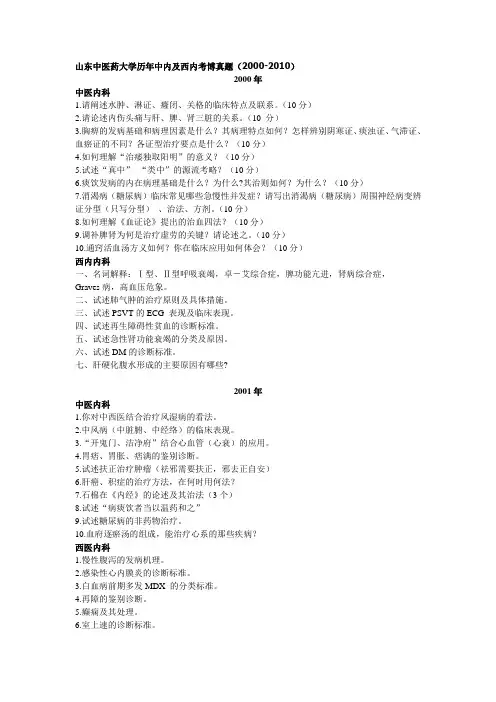
山东中医药大学历年中内及西内考博真题(2000-2010)2000年中医内科1.请阐述水肿、淋证、癃闭、关格的临床特点及联系。
(10分)2.请论述内伤头痛与肝、脾、肾三脏的关系。
(10 分)3.胸痹的发病基础和病理因素是什么?其病理特点如何?怎样辨别阴寒证、痰浊证、气滞证、血瘀证的不同?各证型治疗要点是什么?(10分)4.如何理解“治痿独取阳明”的意义?(10分)5.试述“真中”“类中”的源流考略?(10分)6.痰饮发病的内在病理基础是什么?为什么?其治则如何?为什么?(10分)7.消渴病(糖尿病)临床常见哪些急慢性并发症?请写出消渴病(糖尿病)周围神经病变辨证分型(只写分型)、治法、方剂。
(10分)8.如何理解《血证论》提出的治血四法?(10分)9.调补脾肾为何是治疗虚劳的关键?请论述之。
(10分)10.通窍活血汤方义如何?你在临床应用如何体会?(10分)西内内科一、名词解释:Ⅰ型、Ⅱ型呼吸衰竭,卓-艾综合症,脾功能亢进,肾病综合症,Graves病,高血压危象。
二、试述肺气肿的治疗原则及具体措施。
三、试述PSVT的ECG 表现及临床表现。
四、试述再生障碍性贫血的诊断标准。
五、试述急性肾功能衰竭的分类及原因。
六、试述DM的诊断标准。
七、肝硬化腹水形成的主要原因有哪些?2001年中医内科1.你对中西医结合治疗风湿病的看法。
2.中风病(中脏腑、中经络)的临床表现。
3.“开鬼门、洁净府”结合心血管(心衰)的应用。
4.胃痞、胃胀、痞满的鉴别诊断。
5.试述扶正治疗肿瘤(祛邪需要扶正,邪去正自安)6.肝癌、积症的治疗方法,在何时用何法?7.石棉在《内经》的论述及其治法(3个)8.试述“病痰饮者当以温药和之”9.试述糖尿病的非药物治疗。
10.血府逐瘀汤的组成,能治疗心系的那些疾病?西医内科1.慢性腹泻的发病机理。
2.感染性心内膜炎的诊断标准。
3.白血病前期多发MDX 的分类标准。
4.再障的鉴别诊断。
5.癫痫及其处理。
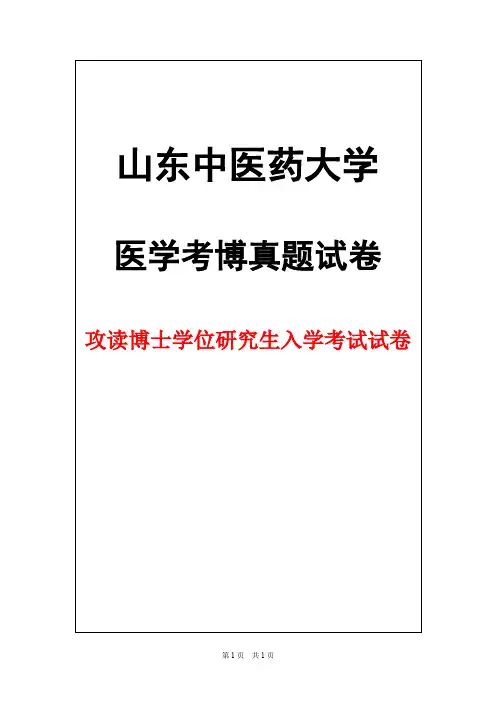

中医博士考试试卷一、选择题(每题2分,共20分)1. 中医理论体系中,“五行”学说中“木”对应的季节是:A. 春B. 夏C. 秋D. 冬2. 以下哪项不是中医“四诊”的内容:A. 望B. 闻C. 问D. 摸3. 中医中“气”的概念,主要指的是:A. 呼吸的空气B. 生命活动的基本物质C. 食物中的营养成分D. 身体中的水分4. 以下哪个不是中医“八法”中的治疗方法:A. 汗B. 吐C. 下D. 补5. 根据中医理论,以下哪项不是影响“肝气”的因素:A. 情绪B. 饮食C. 环境D. 遗传6. 中医认为“脾”的主要功能是:A. 疏泄B. 运化C. 储藏D. 排泄7. 以下哪个是中医“三焦”理论中的“中焦”:A. 心B. 脾C. 肺D. 肾8. 中医理论中,以下哪项不是“五脏”:A. 心B. 肺C. 肾D. 胆9. 中医中“肾”的功能主要是指:A. 呼吸B. 消化C. 生殖D. 排泄10. 中医中“痰”的概念主要指的是:A. 呼吸道分泌物B. 体内湿气的凝聚C. 血液D. 尿液二、简答题(每题10分,共30分)1. 请简述中医“阴阳”学说的基本理论及其在中医诊断和治疗中的应用。
2. 描述中医“五行”学说中的相生相克规律,并举例说明其在中医治疗中的应用。
3. 请解释中医中的“气”、“血”、“津液”三者之间的关系及其在人体健康中的作用。
三、案例分析题(每题25分,共50分)1. 患者,男,45岁,主诉:长期工作压力大,最近出现头晕、失眠、记忆力减退等症状。
请根据中医理论分析可能的病因,并给出相应的治疗建议。
2. 患者,女,35岁,主诉:月经不调,经期腹痛,面色苍白,舌质淡,脉细。
请根据中医理论分析其可能的病理变化,并给出相应的治疗建议。
四、论述题(共30分)请论述中医的整体观念在现代健康管理中的应用及其意义。
五、附加题(10分,选做)请结合个人经验,谈谈中医在现代疾病预防和治疗中的作用。
【注】:本试卷为模拟试卷,旨在考察考生对中医基本理论、诊断方法、治疗原则的掌握程度以及应用能力。
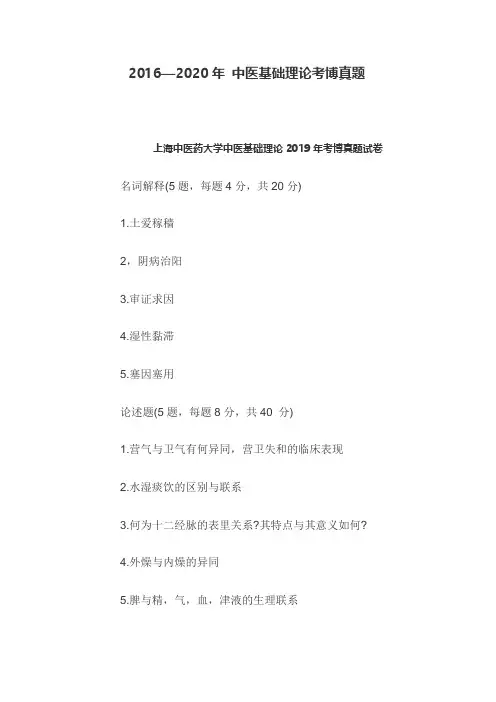
2016—2020年中医基础理论考博真题上海中医药大学中医基础理论2019年考博真题试卷名词解释(5题,每题4分,共20分)1.土爱稼穑2,阴病治阳3.审证求因4.湿性黏滞5.塞因塞用论述题(5题,每题8分,共40 分)1.营气与卫气有何异同,营卫失和的临床表现2.水湿痰饮的区别与联系3.何为十二经脉的表里关系?其特点与其意义如何?4.外燥与内燥的异同5.脾与精,气,血,津液的生理联系湖南中医药大学2018年攻读博士学位研究生入学考试考试科目:中医基础理论注意:所有答案-律写在答题纸上。
写在试题纸上或其他地方--律不给分。
、名词解释1.肝主疏泄2.肺主治节3.循经取穴4. 内生五邪5.塞因塞用6.阴病治阳7.精血同源8. 心肾不交二、简答题1. 脾胃的关系。
2. 饮的分类。
3. 药邪的形成及致病特点。
4.风邪致病的特点。
5.心主神明与脑主神明的认识。
6. 三焦的认识。
7.脏腑之别。
山东中医药大学中医基础理论2018年考博真题考试科目:中医基础理论注意:所有答案-律写在答题纸上,写在试题纸上或其他地方一-律不给分。
论述题: .1.试述心与肾的关系。
2.《内经》中津液的产生与输布。
3.如何理解冲为血海。
4.火热内生的临床表现及致病因素。
5.体质的概念及形成因素。
6.如何理解大实有赢状,至虚有盛候。
7.试述”阴病治阳,阳病治阴”与”阴中求阳,阳中求阴”有何异同?8.试述湿邪致病特点,及与外湿有何异同?9.谈谈对益火补土法的认识及临床中的应用。
山东中医药大学中医基础理论考博真题1.风邪性质和致病特征,为什么说风为百病之长?2.从病机转化角度说明寒证转化为热证的转变形式?3.虚实的病机机制?2018年山东中医药大学博士考试中医基础理论试题1.试述心与肾的关系。
2.《内经》中津液的产生与输布。
3.如何理解冲为血海。
4.火热内生的临床表现及致病因素。
5.体质的概念及形成因素。
6.如何理解大实有羸状,至虚有盛候。
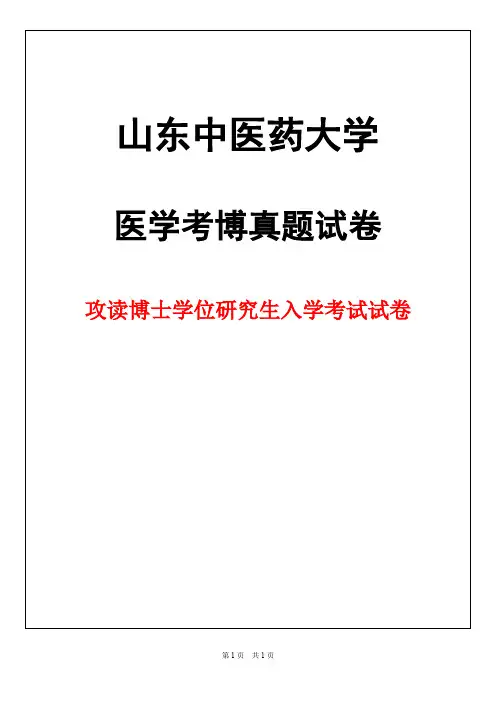

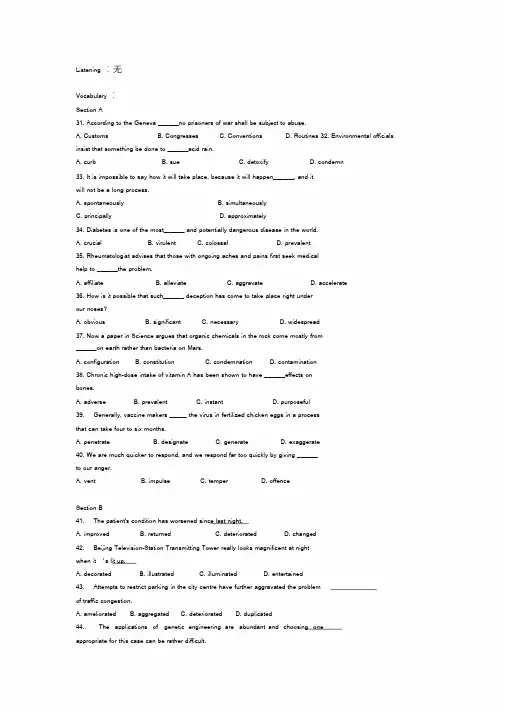
Listening :无Vocabulary :Section A31. According to the Geneva ______no prisoners of war shall be subject to abuse.A. CustomsB. CongressesC. ConventionsD. Routines 32. Environmental officials insist that something be done to ______acid rain.A. curbB. sueC. detoxifyD. condemn33. It is impossible to say how it will take place, because it will happen______, and itwill not be a long process.A. spontaneouslyB. simultaneouslyC. principallyD. approximately34. Diabetes is one of the most______ and potentially dangerous disease in the world.A. crucialB. virulentC. colossalD. prevalent35. Rheumatologist advises that those with ongoing aches and pains first seek medicalhelp to ______the problem.A. affiliateB. alleviateC. aggravateD. accelerate36. How is it possible that such______ deception has come to take place right underour noses?A. obviousB. significantC. necessaryD. widespread37. Now a paper in Science argues that organic chemicals in the rock come mostly from______on earth rather than bacteria on Mars.A. configurationB. constitutionC. condemnationD. contamination38. Chronic high-dose intake of vitamin A has been shown to have ______effects onbones.A. adverseB. prevalentC. instantD. purposeful39. Generally, vaccine makers _____ the virus in fertilized chicken eggs in a processthat can take four to six months.A. penetrateB. designateC. generateD. exaggerate40. We are much quicker to respond, and we respond far too quickly by giving ______to our anger.A. ventB. impulseC. temperD. offenceSection B41. The patient's condition has worsened since last night.A. improvedB. returnedC. deterioratedD. changed42. Beijing Television-Station Transmitting Tower really looks magnificent at nightwhen it ’s lit up.A. decoratedB. illustratedC. illuminatedD. entertained43. Attempts to restrict parking in the city centre have further aggravated the problemof traffic congestion.A. amelioratedB. aggregatedC. deterioratedD. duplicated44. The applications of genetic engineering are abundant and choosing oneappropriate for this case can be rather difficult.A. sufficientB. plentifulC. adequateD. countable45. The defect occurs in the first eight weeks of pregnancy, though no one understandswhy.A. deficitB. deviationC. draw backD. discrepancy46. He has been on hormone alternate therapy for four years and looks fantastic.A. successorB. replacementC. surrogateD. choice47. It had over 2,000 apartment complexes, a great market, a large number ofindustrial workshops, an administrative center, a number of massive religious edifices,and a regular grid pattern of streets and buildings.A. ancientB. carefullyC. very largeD. carefully protected48. When patients spend extended periods in hospital, they tend to become overlydependent and lose interest in taking care of themselves.A. extremelyB. exclusivelyC. exactlyD. explicitly49. The anxious parent was vigilant over the injured child in spite of a full array ofemergency room of doctors and nurses.A. preoccupiedB. unwaryC. watchfulD. dozing50. The doctor vacillated so frequently on disease-preventiontechniques that hiscolleagues accused him of inconsistency.A. waveredB. instigatedC. experimentedD. reliedClozeWe spend a lot of time looking at the eyes of others for social 51 —it helpsus understand a person ’emotions, and make decisions about how to respond to them. We also know that adults avoid eye contact when anxious. But researchers have knownfar 52 about eye gazing patterns in children.According to new research by Kalina Michalska, assistant professor of psychologyat the University of California, Riverside, we now, know that anxious children tend toavoid making eye contact, and this has consequences for how they experience fear. The53 and less frequently they look at the eyes of others, the more likely they are to beafraid of them, even when there may be no reason to be. Her study, “Anxiety Sympand Children's Eye Gaze During Fear Leaming”w,as published in the journal TheJournal of Child Psychology and Psychiatry."Looking at someone ’s eyes helps us understand whether a person is feeling sad, angry, fearful, or surprised. As adults, we then make decisions about how to respondand what to do next. But, we know much less about eye patterns in children —so,understanding those patterns can help us learn more about the development of sociallearning, ”Michalska said.Michalska and the team of researchersshowed 82 children, 9 to 13 years old,images of two women ’s faces on a computer screen. The computer was equipped withan eye tracking device that allowed them to measure54 on the screen children werelooking, and for how long. The participants were originally shown each of the twowomen a total of four times. Next, one of the images was55 with a loud scream anda fearful expression, and the other one was not. At the end, children saw both facesagain without any sound or scream.The following three conclusions can be drawn from the study:1. All children spent more time looking at the eyes of a face that was paired withthe loud scream t han the face that was not paired with the scream, 56 they payattention to potential threats even in the absence of outward cues.2. Children who were more anxious avoided eye contact during all three phases of the experiment, for both kinds of faces. This had consequences for how afraid they wereof the faces.3. The more children avoided eye conta;cthe more afraid they were 57 the faces.The conclusions suggest that children spend more time looking at the eyes of aface when previously paired with something frightening suggesting they pay moreattention to potentially threatening information as a way to learn more about thesituation and plan what to do next.However, anxious children tend to avoid making eye contact, which leads togreater 58 experience. Even though avoiding eye contact may reduce anxiety59 , the study finds that — over time — children may be m i s s6i n0g_ o i m u p t ortantsocial information. This includes that a person may no longer be threatening or scary,and yet the child continues feeling fearful of that person.51. A. environment B. cues C. relations D. answers52. A. less B. more C. enough D. beyond53. A. longer B. more anxious C. shorter D. more54. A. where B. when C. how D. what55. A. followed B. recorded C. paired D. marked56. A. suggest B. suggesting C. suggests D. being suggested57. A. to B. of C.at D. about58. A. fear B. surprise C. sad D. angry59. A. in the long run B. for a long timeC. in the short timeD. in a long time60. A. with B. without C. of D. onReading ComprehensionPassage OneThe British psychoanalyst John Bowlby maintains that separation from the parentsduring the sensitive “attachment p”e riod from birth to three may scar a child ’s personality and predispose to emotional problems in later life.Some people have drawn the conclusion from Bowlby' s work that children shouldnot be subjected to day care before the age of three because of the parental separationit entails, and many people do believe this. It has been argued that an infant under threewho is cared for outside the home may suffer because of the separation from his parents. But there are also arguments against such a strong conclusion.But traditional societies are so different from modem societies that comparisonsbased on just one factor are hard to interpret. Firstly, anthropologists point out that theinsulated love affair between children and parents found in modem societies does notusually exist in traditional societies. For example, in some tribal societies, such as theNgoni, the father and mother of a child did not rear their infant alone —far from i Certainty, Bowlby ’s analysis raises the possibilities that early day care had delayedeffects. The possibility that such care might lead to, say, more mental illness or crime15 or 20 years later can only explored by the use of statistics. However, statisticalstudies of this kind have not yet been carried out, and even if they were, the resultswould certainly be complicated and controversial. Secondly, common sense tells us that day care would not be so widespread today if parents, care-takers found children hadproblems with it. Thirdly, in the last decade, t here have been a number of careful American studies of children in day care, and they have uniformly reported that care had a neutral or slightly positive effect on children ’s development.Whatever the long-term effects, parents sometimes find the immediate effectsdifficult to deal with. Children under three are likely to protest at leaving their parentsand show unhappiness. At the age of three or three and a half almost all children findthe transition to nursery eas,yand this is undoubtedly why more and more parents make use of child care at this time. The matter, then, is far from clear-cut, though experienceand available evidence indicate early care is reasonable for infants.61. According to the passage, the consequence of parental separation________.A. still needs more statistical studiesB. has been found negative is more seriousC. is obviousD. in modem times62. The author thinks that John Bowlby ’s concern___________.A. is relevant and justifiableB. is too strong to RelieveC. is utterly groundlessD. has something that deserve our attention63. What ’s the result of American studies of children in day care in the last decade?A. The children ’s unhappiness and protest was due to the day care the children received.B. The bad effects of parental separation were hard to deal with.C. The effect of day care was not necessarily negative on children ’s development.D. Early care was reasonable for babies since it ’p sracti c ed by so many peoplenowadays.64. According to the passage, which of the following is probably a reason forparents to send their children under three to day care?A. They don ’t know about day care ’s negative effect.B. They are too busy to care fortheir children.C. They want their children to be independent as early as possible.D. They want to facilitate their children to adapt to nursery at the age of about three.65. What ’s the author ’s attitude to people who have drawn the conclusion fromBowlby’s work that children should not be subjected to day care before the age ofthree?A. He supports most of their belief because Bowlby's proposition is well-grounded.B. He is sympathetic for them, for he thinks they have been misled by Bowlby.C. He doesn't totally agree with them, since the long-term effect of day care still needsfurther study.D. He doesn't quite understand them, as they are contradictory in themselves.Passage TwoBy the end of this century, the average world temperature is expected to increasebetween one and four degrees, with widespread effects on rainfall, sea levels and animalhabitats. But in the Arctic, where the effects of climate change are most intense, the risein temperature could be twice as much.Understanding how Arctic warming will affect the people, animals, plant andmarine life and economic activity in Canada’N sort h are important to the country's future, says Kent Moore, an atmospheric physicist at University of Toronto Mississaugawho is participating in a long-term, international study of the marine ecosystem alongthe Beaufort Sea, from Alaska to the Mackenzie delta.The study will add to our knowledge of everything from the extent of sea ice inthe region to how fish stocks will change to which areas could become targets for oiland gas exploration to the impact on the indigenous people who call this part of thecountry home.Moore, who has worked in the Arctic for more than 20 years, says his research hasalready found that thinning sea ice and changes in wind patterns are causing animportant change in the marine food chain: phytoplankton(淳游植物) is blooming two to three weeks earlier. Manyanimals time their annual migration to the Arctic forwhen food is plentiful, and have not adapted to the earlier bloom. " ' Animals' behaviorcan evolve over a long time, but these climate changes are happening in the space of adecade, r ather than hundreds of years, ”says Moore, " Animals can't change theirbehavior that quickly. ”A warmer Arctic is expected to have important effects on human activity in theregion, as the Northwest Passage becomes navigable during the summer, and resourceextraction becomes more feasible. Information gained from the study will helpgovernment, industry and communities make decisions about resource management,economic development and environmental protection.Moore says the study — which involves Canadian, American and Europeanresearchersand government agencies will also use a novel technology to gatheratmospheric data: remotely piloted drones. "The drones have the capability of a largeresearch aircraft,and they ’re easier to deploy, ” he says, showing the researchers to gather information on a more regular basis than they would be able to with pilotedaircraft.66. By the end of this century, according to the author, global warming will ______.A. start to bring about extreme weather events to humans and animalsB. increase the average world temperature by four degreesC. cause more damages to the whole world than expectedD. affect the Arctic more than any other parts of the earth67. To help understand the destructive mechanism of Arctic warming, as indicatedby the passage, the international study ______.A. is conducted with every single discipline of University of TorontoB. pioneers in pursuing the widespread effects of climate changeC. involves so many countries for different investigationsD. is intended to deal with various aspects in research68. When he ways, “Animals can ’t change their behavior that quickly, ”what doesMoore mean by that quickly?A. The migration of the animals to the Arctic.B. The widespread effects of global warming.C. The rate of the climate change in the Arctic.D. The phytoplankton within the marine ecosystem.69. According to the author, to carry out proper human activities in theArctic______.A. becomes more difficult than ever beforeB. is likely to build a novel economy in the regionC. will surely lower the average world temperatureD. needs the research-based supporting information70. With the drones deployed, as Moore predicts, the researchers will _______.A. involve more collaborating countries than they do nowB. get more data to be required for their researchC. use more novel technologies in researchD. conduct their research at a regular basisPassage ThreeHaving too much caffeine during pregnancy may impair baby ’s liver development and increase the risk of liver disease in adulthood, according to a study published in theJournal of Endocrinology. Pregnant rats given caffeine had offspring with lower birth weights, altered growth and stress hormonelevels and impaired liver development. Thestudy findings indicate that consumption of caffeine equivalent to 2-3 cups of coffee may alter stress and growth hormone levels in a manner that can impair growth and development, and increase the risk of liver disease in adulthood.Previous studies have indicated that prenatal caffeine intake of 300 mg/day ormore in women, which is approximately 2 to 3 cups coffee per day, can result in lower birth weights of their children. Animalstudies have further suggestedthat prenatalcaffeine consumption may have more detrimental long-term effects on liverdevelopment with an increased susceptibility to non-alcoholic fatty liver disease, adebilitating condition normally associated w ith obesity and diabetes. However, theunderlying link between prenatal caffeine exposure and impaired liver developmentremains poorly understood. A better understanding of how caffeine mediates theseeffects could help prevent these health issues in people in the future.In this study, Prof Hui Wang and colleagues at Wuhan University in China,investigated the effects of low (equivalent to 2-3 cups of coffee) and high dose(equivalent of 6-9 cups of coffee) caffeine, given to pregnant rats, on liver function andhormone levels of their offspring. Offspring exposed to prenatal caffeine had lower levels of the liver hormone, insulin likegrowth factor (IGF-1), and higher levels of thestress hormone, corticosteroid at birth. However, liver development after birth showed a compensatory 'catch up' phase, characterised by increased levels of IGF-1, which is important for growth.Dr. Yinxian Wen, study co-author, says, “Our results indicate that prenatal caffeine causes an excess of stress hormone activity in the mother, which inhibits IGF-1 activityfor liver development before birth. However, compensatory mechanisms do occur after birth to accelerate growth and restore normalliver function, as IGF-1 activity increasesand stress hormone signalling decreases. The increased risk of fatty liver disease causedby prenatal caffeine exposure is most likely a consequence of this enhanced,compensatory postnatal IGF-1 activity. ”These findings not only confirm that prenatal caffeine exposure leads to lowerbirth weight and impaired liver development before birth but also expand our currentunderstanding of the hormonal changes underlying these changes and suggest thepotential mechanism for increased risk of liver disease in the future. However, theseanimal findings need to be confirmed in humans.Dr. Wen comments, "Our work suggeststhat prenatal caffeine is not good for babies and although these findingsstill need to be confirmed in people, I wouldrecommend that women avoid caffeine during pregnancy."71. Which of the following is NOT the problem of baby rats of pregnant rats givencaffeine?A. Lower birth weight.B. Smaller stress.C. Liver development problem.D. Growth problem.72. If a pregnant woman takes 3 cups of coffee, what will probably happen?A. Her weight will get lower and lower.B. The weight of her baby will get lower and lower.C. She will suffer from non-alcoholic fatty liver disease in a long run.D. Her baby will be more vulnerable to obesity and diabetes because of liver problem.73. Which of following is not correct according to the passage?A. A better understanding of the relationship between caffeine and effects has beenachieved.B. 4-5 cups of coffee could be categorized as medium-dose intake.C. Liver development problem may be remedied after birth by increased growth factor.D. The study is mainly conducted on the rats instead of human.74. What is the relationship between stress hormone and liver development whentaking in prenatal caffeine?A. Lower stress hormone, lower birth weight before birth.B. Higher stress hormone, lower growth hormone before birth.C. Higher stress hormone, more accelerated growth of weight after birth.D. Lower stress hormone, less accelerated growth of liver after birth.75. What can be the best summary of the last paragraph?A. The research hasn ’t been done on humans so pregnant women can ignore the results.B. The compensatory mechanism for liver growth makes prenatal caffeine intake safe.C. Experts suggest pregnant women should still avoid caffeine.D. We have known enough about the hormone changes underlying the healthPassage FourThe bizarre antics of sleepwalkers have puzzled police, perplexed scientists, and fascinated writers for centuries. There is an endless supply of stories about sleepwalkers.Persons have been said to climb on steep roofs, solve mathematical problems, composemusic, walk through plate-glass windows, and commit murder in their sleepHow many of these stories have a basis in fact, and how many are pure fakery?No one knows, but if some of the most sensational stories should be taken with a barrelof salt, others are a matter of record.In Revere, Massachusetts, a hundred policemen combed a waterfrontneighborhood for a lost boy who left his home in his sleep and woke up five hours lateron a strange sofa in a strange living room, with no idea how he had got there.There is an early medical record of a somnambulist who wrote a novel in his sleep.And the great French writer V oltaire knew a sleepwalker who once got out of bed,dressed himself, made a polite bow, danced a minuet, and then undressed and went backto bed.At the University of Iowa, a student was reported to have the habit of getting upin the middle of the night and walking three-quarters of a mile to the Iowa River. He would take a swim and then go back tohis room to bed.The world's champion sleepwalker was supposed to have been an Indian, PanditRamrakha, who walked sixteen miles along a dangerous road without realizing that hehad left his bed. Second in line for the title is probably either a Vienna housewife or a British farmer. The woman did all her shopping on busy streets in her sleep. The farmer,in his sleep, visited a veterinarian miles away.The leading expert on sleep in America claims that he has never seen a sleepwalker.He is Dr. Nathaniel Kleitman, a physiologist at the University of Chicago. He is said toknow more about sleep than any other living man, and during the last thirty-five yearshad lost a lot of sleep watching people sleep. Says he, "Of course, I know that there are sleepwalkers becauseI have read about them in the newspapers. B ut none of mysleepers ever walked, and if I were to advertise for sleepwalkers for an experiment, Idoubt that I'd get many takers."Sleepwalking, nevertheless, is a scientific reality. Like hypnosis, it is one of thosedramatic, eerie, awe-inspiring phenomena that sometimes border on the fantastic. Itlends itself to controversy and misconceptions, what is certain about sleepwalking isthat it is a symptom of emotional disturbance, and that the only way to cure it is to remove the worries and anxieties that cause it. Doctors say that somnambulism is muchmore common than is generally supposed.Some have estimated that there are fourmillion somnambulists in the United States. Others set the figure even higher. Manysleepwalkers do not seek help and so are never put on record, which means that anaccurate count can never be made.The simplest explanation of sleepwalking is that it is the acting out of a vividdream. The dream usually comes from guilt, worry, nervousness, o r some otheremotional conflict. The classic sleepwalker is Shakespeare ’L asdy Macbeth. Hernightly wanderings were caused by her guilty conscience at having committed murder. Shakespeare said of her, “The eyes are open but their sense is shut. ”The age-old question is: Is the sleepwalker actually awake or asleep. Scientists have decided that he is about half-and-half. Like Lady Macbeth, he has weightyproblems on his mind. Dr. Zeida Teplitz, who made a ten-year study of the subject, says, “Some people stay awake all night worrying about t heir problems. The sleepwalker thrashes them out in his sleep. He is awake in the muscular area, partially asleep in the sensory area." In other words, a person can walk in his sleep, move around, and do other things, but he does not think about what he is doing.76. The second sentence in the second paragraph means that_________.A. no one knows, but certainly all the sleep walking stories have something incredibleB. the sleepwalking stories are like salt adding flavor to people ’s lifeC. sleepwalking stories that are most fantastic should be sorted out from ordinary storiesD. the most fantastic sleepwalking stories may be just fictions, yet there are stilltruthfully recorded stories77. ________was supposed to be the world's champion sleepwalker.A. The student habitually walked to the Iowa River and swam in his sleepB. The man danced a minuet in his sleepC. The man walker sixteen miles along a dangerous roadD. The boy walked five hours in his sleep78. Sleepwalking is the result of ______ according to the passage.A. emotional disorderB. a vivid dreamC. lack of sleep and great anxietyD. insanity79. Dr. Zeida Teplitz seemed to_________.A. agree that sleepwalking sometimes leads to dangerous actsB. conclude that sleepwalkers are awake in their sensory areaC. disagree with the belief that sleep walkers are immune to injuryD. think that sleepwalking can turn into madness80. The writer makes it obvious that_________.A. sleepwalkers are often awakened by dangersB. most sleepwalkers can find ways to avoid self-injuryC. it is important to find out the underlying cause of sleepwalkingD. sleepwalking is actually a kind of hypnosisPassage FiveBeyond the basic animal instincts to seek food and avoid pain, Freud identifiedtwo sources of psychic energy, which he called "drives ”: aggression and libido. The keto his theory is that these were unconscious drives, shaping our behavior without themediation of our waking minds; they surface, heavily disguised, only in our dreams.The work of the past half-century in psychology and neuroscience has been to downplaythe role of unconscious universal drives, focusing instead on rational processesinconscious life. But researchers have found evidence that Freud s drives really do exist,and they have their roots in the limbic system, a primitive part of the brain that operatesmostly below the horizon of consciousness.Now more commonly referred to as emotions, the modem suite of drives comprises five: rage, panic, separation distress,lust and a variation on libido sometimes called seeking.The seeking drive is proving a particularly fruitful subject for researchers.Although like the others it originates in the limbic system, it also involves parts of theforebrain, the seat of higher mental functions. In the 1980s, Jaak Panksepp, aneurobiologist at Bowling Green State University in Ohio, became interested in a placenear the cortex known as the ventraltegmental area, which in humans lies just abovethe hairline. When Panksepp stimulated the corresponding region in a mouse, theanimal would sniff the air and walk around, as though it were looking for something.Was it hungry? No. The mouse would walk right by a plate of food, or for that matterany other object Panksepp could think of. This brain tissue seemed to cause a generaldesire for something new. “What I was seeing, ” he says, “was the urge to do stuff.Panksepp called this seeking.To neuropsychologist Mark Solms of University College in London, that soundsvery much like libido. “Freud needed some sort of general, appetitive desire to seekpleasure in the world of objects, ” says Solms. "Panksepp discovered as a neuroscientist what Freud discovered psychologically. ” Solms studied the same region of the brain forhis work on dreams. Since the 1970s, neurologists have known that dreaming takesplace during a particular form of sleep known as REM — rapid eye movement — whichis associated with a primitive part of the brain known as the pons. Accordingly, they regarded dreaming as a low-level phenomenon of no great psychological interest. WhenSolms looked into it, though, it turned out that the key structure involved in dreaming was actually the ventral tegmental, the same structure that Panksepp had identified as the seat of the “”s e e m k i o n t g i o n. Dreams, it seemed, originate with the libid—o which is just what Freud had believed.Freud's psychological map may have been flawed in many ways, but it alsohappensto be the most coherent and, from the standpoint of individual experience,meaningful theory of the mind. “Freud should be placed in the same category as Darwin,who lived before the discovery of genes, ” says Panksepp. “Freud gave us a vision ofmental apparatus. We need to talk about it, develop it, test it. ” Perhaps it ’sof proving Freud wrong or right, but of finishing the job.。
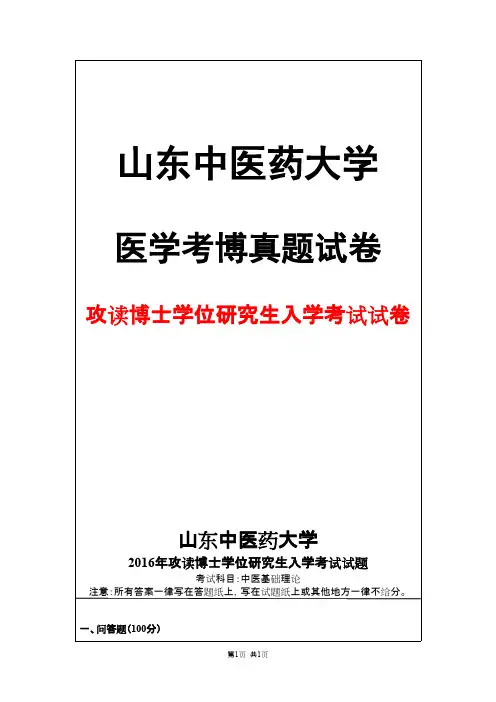

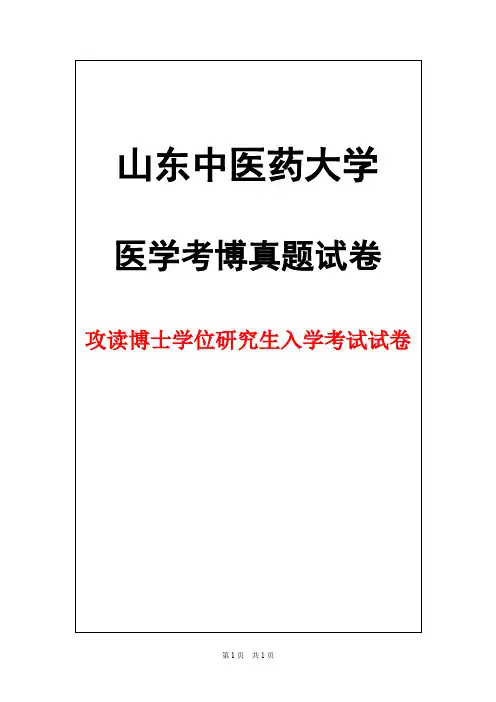
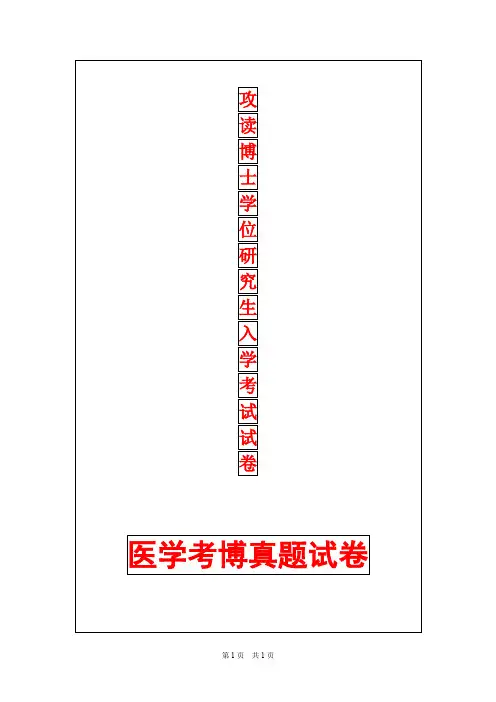
山东中医药大学历年考博真题2000 年中医内科1.请阐述水肿、淋证、癃闭、关格的临床特点及联系。
(10分)2.请论述内伤头痛与肝、脾、肾三脏的关系。
(10分)3.胸痹的发病基础和病理因素是什么?其病理特点如何?怎样辨别阴寒证、痰浊证、气滞证、血瘀证的不同?各证型治疗要点是什么?(10分)4.如何理解“治痿独取阳明”的意义?(10分)5.试述“真中” “类中”的源流考略?(10分)6.痰饮发病的内在病理基础是什么?为什么?其治则如何?为什么?(10分)7.消渴病(糖尿病)临床常见哪些急慢性并发症?请写出消渴病(糖尿病)周围神经病变辨证分型(只写分型)、治法、方剂。
(10分)8.如何理解《血证论》提出的治血四法?(10分)9.调补脾肾为何是治疗虚劳的关键?请论述之。
(10分)10.通窍活血汤方义如何?你在临床应用如何体会?(10分)2001 年中医内科1.你对中西医结合治疗风湿病的看法。
2.中风病(中脏腑、中经络)的临床表现。
3.“开鬼门、洁净府”结合心血管(心衰)的应用。
4.胃痞、胃胀、痞满的鉴别诊断。
5.试述扶正治疗肿瘤(祛邪需要扶正,邪去正自安)6.肝癌、积症的治疗方法,在何时用何法?7.石棉在《内经》的论述及其治法(3个)8.试述“病痰饮者当以温药和之”9.试述糖尿病的非药物治疗。
10.血府逐瘀汤的组成,能治疗心系的那些疾病?2002 年中医内科1.中医痿证与西医的神经系统哪些疾病有关2.治痿独取阳明的含义3.无痰无不作眩的病机含义怎样理解“病痰饮者当以温药合之”高血压如何辨证,降压中药有哪些4.胸闷病机、症状、治法、代表方剂5.天王补心丹、朱砂安神丸、黄连阿胶汤、知柏地黄汤心悸如何区别应用,方药组成6.湿邪困脾的脉症特点7.活血化瘀在急慢性白血病中如何应用8.消渴病机、症状,消渴肾脏病时真武汤、济生肾气丸适应症多时什么,方药组成。
2003 年中医内科1.名词解释:逆流挽舟、提壶揭盖、延痹、关格、绝汗2.结合腹痛的病机,谈谈痛证的治疗大法3.气臌、血臌的临床特征、治法、方药4.治疗虚劳时,运用补益法应注意的问题5.何谓“厥证”?《内经》如何论述的?6.运用《内经》的阴阳营卫的观点,阐述寤寐的生理、病理7.古代文献对脑的生理功能的认识8.痹证在古代的分类方法、近代如何分类?9.高脂血症的病因病机10.病例分析题:述其正确的诊断、证型、方药2004 年中医内科1.失眠的主要病因病机有哪些?如何理解“胃不合则卧不安”?2.从汗为心之液的基本理论,结合临床简述心病与汗证在病机上的关联及主要的治法方药。